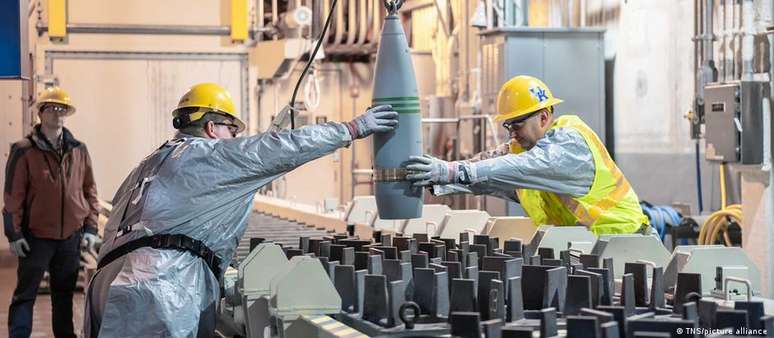Decades late, the destruction of stockpiles of sarin gas rockets stored since the 1940s at a US base ends the world’s last declared chemical weapons arsenal. officially declared arsenal of its kind left in the world.
The destruction of the last remaining rockets containing the GB nerve agent, also known as sarin, will end a decades-long campaign to destroy an arsenal that at the end of the Cold War amounted to more than 30,000 tons.
Chemical weapons were first used in modern warfare during World War I, in which these munitions are estimated to have killed at least 100,000 people. Despite being later banned by the so-called Geneva Protocol, which was signed in 1925 and entered into force three years later, countries continued to stockpile chemical weapons for decades.
September 30 of this year was set as the deadline for the United States to end its arsenal under the Chemical Weapons Convention, an international agreement that went into effect in 1997 and has 193 countries signing on.
In Kentucky, the last of a total of 51,000 rockets containing the lethal agent sarin that have been stored since the 1940s in the warehouse, located near the city of Richmond, is being disposed of. According to a report published by the New York Times on Thursday (06/07), the destruction would be completed in the next few days, perhaps as early as this Friday.
Another US military installation, near Pueblo, in the state of Colorado, recently completed the destruction of the last chemical weapons it housed, which began in 2016. The mission to eliminate approximately 2,600 tons of mustard gas-filled shells and mortars was completed last year on June 22nd.
These represented approximately 8.5% of the agent’s original stock of 30,610 tonnes. In total, some 800,000 mustard gas munitions have been stored in concrete bunkers in a rural area east of Pueblo since the 1950s.
decades of struggle
In the 1980s, nearby residents of the Blue Grass military depot in Kentucky protested initial plans to incinerate the 520 tons of chemical weapons stored there, starting a decade-long battle over how to dispose of the arsenal.
The US military has disposed of most of its chemical weapons by incinerating them in more remote locations, such as Johnston Atoll in the Pacific and a depot in the middle of the Utah desert. But the Kentucky facility is close to Richmond, a few dozen miles from Lexington, the state’s second-largest city, and less than a mile from a school.
Craig Williams, who became the leading voice of popular opposition, said residents feared that incinerating the chemicals would release toxic gases. With the help of lawmakers, the population was able to persuade the army to come up with alternative plans for the destruction.
The Blue Grass Depot housed mustard agent and the nerve agents VX and sarin, largely in rockets and other projectiles, from 1940 onward. The state disposal facility was completed in 2015 and began to destroy weapons in 2019.
The facility uses a process called neutralization to dilute deadly agents so they can be safely disposed of. At both the Kentucky disposal facility and Pueblo, Colorado, robots were used to dispose of the weapons.
Chemical weapons in the world
Kingston Reif, who has been advocating for years of disarmament and now serves as the US deputy secretary of defense for threat reduction and arms control, said the complete destruction of the country’s chemical arsenal “will close an important chapter in military history”.
Officials consider the elimination of the US arsenal a major step forward under the Chemical Weapons Convention. Only three countries – Egypt, North Korea and South Sudan – have not signed the treaty. Israel has signed but not ratified the agreement.
Reif points out that there is still concern that signatory countries, especially Russia and Syria, have undeclared stockpiles of chemical weapons. Officially, Russia destroyed its arsenal in 2017, after the UK and India did the same in 2007 and 2009 respectively.
The Chemical Weapons Convention did not end the use of this type of ammunition. In the Syrian civil war, forces loyal to President Bashar al-Assad repeatedly used chemical weapons in the country between 2013 and 2019. And according to the IHS Conflict Monitor, a London-based organization that analyzes intelligence data, “Islamic State” used chemical weapons at least 52 times in Iraq and Syria from 2014 to 2016, reports the New York Times.
Arms control activists hope the milestone achieved by the United States could motivate countries that have not yet destroyed their chemical weapons to do so and also be used as a model for the destruction of other types of munitions.
“It demonstrates that countries can effectively ban weapons of mass destruction,” says Paul F. Walker, vice president of the Arms Control Association and coordinator of the Coalition for the Chemical Weapons Convention. “If countries want to do that, it just takes political will and a good control system.”
lf (AFP, ots)
Source: Terra
Rose James is a Gossipify movie and series reviewer known for her in-depth analysis and unique perspective on the latest releases. With a background in film studies, she provides engaging and informative reviews, and keeps readers up to date with industry trends and emerging talents.






